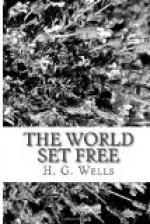Every step farther would have been as dangerous as a descent within the crater of an active volcano. These spinning, boiling bomb centres would shift or break unexpectedly into new regions, great fragments of earth or drain or masonry suddenly caught by a jet of disruptive force might come flying by the explorer’s head, or the ground yawn a fiery grave beneath his feet. Few who adventured into these areas of destruction and survived attempted any repetition of their experiences. There are stories of puffs of luminous, radio-active vapour drifting sometimes scores of miles from the bomb centre and killing and scorching all they overtook. And the first conflagrations from the Paris centre spread westward half-way to the sea.
Moreover, the air in this infernal inner circle of red-lit ruins had a peculiar dryness and a blistering quality, so that it set up a soreness of the skin and lungs that was very difficult to heal....
Such was the last state of Paris, and such on a larger scale was the condition of affairs in Chicago, and the same fate had overtaken Berlin, Moscow, Tokio, the eastern half of London, Toulon, Kiel, and two hundred and eighteen other centres of population or armament. Each was a flaming centre of radiant destruction that only time could quench, that indeed in many instances time has still to quench. To this day, though indeed with a constantly diminishing uproar and vigour, these explosions continue. In the map of nearly every country of the world three or four or more red circles, a score of miles in diameter, mark the position of the dying atomic bombs and the death areas that men have been forced to abandon around them. Within these areas perished museums, cathedrals, palaces, libraries, galleries of masterpieces, and a vast accumulation of human achievement, whose charred remains lie buried, a legacy of curious material that only future generations may hope to examine....
Section 4
The state of mind of the dispossessed urban population which swarmed and perished so abundantly over the country-side during the dark days of the autumnal months that followed the Last War, was one of blank despair. Barnet gives sketch after sketch of groups of these people, camped among the vineyards of Champagne, as he saw them during his period of service with the army of pacification.
There was, for example, that ‘man-milliner’ who came out from a field beside the road that rises up eastward out of Epernay, and asked how things were going in Paris. He was, says Barnet, a round-faced man, dressed very neatly in black—so neatly that it was amazing to discover he was living close at hand in a tent made of carpets—and he had ’an urbane but insistent manner,’ a carefully trimmed moustache and beard, expressive eyebrows, and hair very neatly brushed.
‘No one goes into Paris,’ said Barnet.
‘But, Monsieur, that is very unenterprising,’ the man by the wayside submitted.




